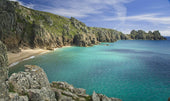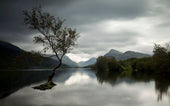A Photographer’s Guide to Capturing Westcombe Bay: Starbursts, Sunsets, and Coastal Beauty
Photographer’s Guide to Capturing Westcombe Bay: Starbursts, Sunsets, and Coastal Beauty
Westcombe Bay also known as Wyscombe beach nestled in the South Hams of South Devon, is a dream location for landscape photographers. With its dramatic headlands, rugged rocks, and captivating sunsets, this secluded cove offers endless creative opportunities. Let's explore how to make the most of a trip to Westcombe Bay, which includes tips for capturing starburst effects and composing stunning sunset shots.
Why Westcombe Bay?
Westcombe Bay is a gem of South Devon’s coastline, known for its raw beauty and serene atmosphere. Accessible only by foot, it feels untouched and far removed from the hustle and bustle of more tourist-heavy spots. For photographers, the bay offers:
- Dramatic headlands: Two prominent peaks frame the cove, providing natural compositional elements.
- Unique rock formations: At low tide, jagged rocks emerge from the sea, adding depth and texture to your images.
- Glorious sunsets: If you get the timing correct, the sun sets between the headlands, creating a mesmerizing scene perfect for photography.
Best Time to Visit
Timing is crucial when planning a photography trip to Westcombe Bay.
- Low tide: The rocks, an essential element for foreground interest, are only fully visible at low tide. Check tide times before heading out.
- Golden hour: The hour before sunset offers soft, golden light that enhances the bay's natural beauty.
- Post-sunset: Stay after the sun dips below the horizon for vivid cloud colours that can create stunning long-exposure shots.
Gear Recommendations
For landscape photography at Westcombe Bay, consider packing the following:
- Wide-angle lens: Ideal for capturing the vastness of the scene. A 16–35mm lens works perfectly.
- Tripod: Essential for stability, especially when shooting starbursts or during low-light conditions.
- Filters: A graduated ND filter helps balance the bright sky with the darker foreground.
How to Capture the Perfect Starburst
Starburst photography adds a magical touch to sunsets, creating radiant beams of light from the sun. Follow these tips for optimal results:
Choose the Right Lens
- Lenses with a higher number of aperture blades produce more defined and aesthetically pleasing starbursts.
- The Canon 16–35mm f/4 lens is an excellent choice, but even budget lenses can achieve decent results.
- Use a small aperture (high f-stop number) such as f/18 or higher. This narrows the light entering the lens, creating the starburst effect.
- Avoid going too high if your lens struggles with diffraction at extreme apertures.
- Place the sun partially obscured by an object, such as a rock or headland, to enhance the starburst effect.
- Focus on a distant element, like a rock or the horizon, to maintain sharpness throughout the frame.
Composition Tips for Westcombe Bay
- Frame the Peaks: Use the two headlands as natural framing elements. Position the sun between them for a striking focal point.
- Incorporate Foreground Interest: At low tide, include the exposed rocks to add depth and lead the viewer’s eye into the scene.
- Experiment with Angles: Explore the beach to find unique perspectives. A low angle might emphasize reflections in the wet sand, while a higher vantage point showcases the expansive coastline.
Post-Sunset Magic
After the sun sets, the magic doesn’t end. The clouds often take on fiery hues, creating opportunities for breathtaking images. Use these tips to extend your shooting session:
- Long Exposures: Capture smooth, silky water by using a long shutter speed.
- Cloud Movement: A longer exposure also creates dreamy streaks in the clouds, adding dynamism to the image.
- Foreground Rocks: As the tide recedes, focus on the shapes and textures of the rocks for moody, minimalist compositions.
Getting to Westcombe Bay
Access and Parking
Westcombe Bay is an adventure to reach. Here’s what you need to know:
- Park at the nearby village of Kingston and follow the footpath to the bay. The scenic walk involves uneven terrain, so sturdy footwear is recommended.
- Park at the Aymer Cover Carpark and walk along the headland.
- Pack light, as the hike can be challenging with heavy gear.
Final Thoughts
Westcombe Bay is a must-visit location for landscape photographers seeking dramatic coastal scenes and unforgettable sunsets. With careful planning and the tips shared here, you’ll leave with images that capture the essence of this stunning Devon cove.
Whether you’re after the dazzling starburst effect or the serenity of a post-sunset glow, Westcombe Bay delivers an experience that’s as rewarding as the photos you’ll take home.
So grab your gear, check those tide times, and head to one of Devon’s most picturesque coastal treasures.
Local map of Westcombe bay
Meet the Author:
I am a Devon based photographer, who enjoys travel, hiking, rugby and photographing the beautiful world in which we live in, I see photography as a creative expression upon visiting beautiful places. Each picture often tells a story.
Thank you for reading this article, please feel to share it with your friends and please check out all my photography - Wall Art and Framed Prints and our Cornish Seascape Prints for Sale
Thanks
Sebastien Coell Photography





